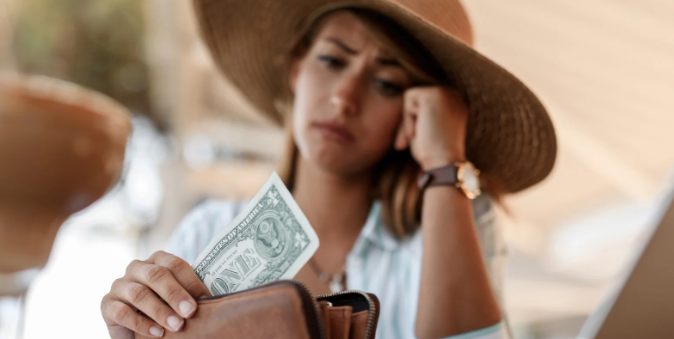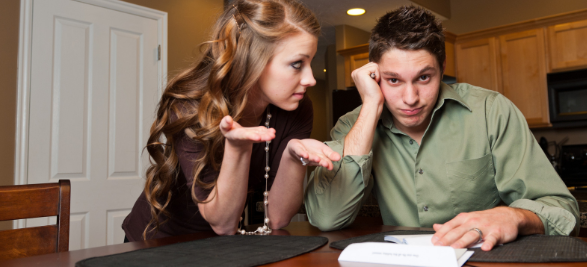'Thrown into adulthood without a map': Americans share why they live paycheck to paycheck
"Lord help you if you don’t have dental insurance and need root canals."

A woman and her husband doing their bills.
It’s a little tricky to determine how many Americans live paycheck to paycheck because the term is vague. Some people, who have plenty of money in savings, say they live paycheck to paycheck because they spend all of their money before their next check arrives. However, they make ample contributions to their savings accounts and are in good financial shape. Others genuinely spend every dime they make and have very little savings to deal with an emergency.
How many Americans live paycheck to paycheck?
The Federal Reserve found that 54% of Americans have emergency savings to cover three months of expenses, and Bankrate found that, while 59% of Americans are uncomfortable with their level of emergency savings, 34% are living paycheck to paycheck. According to CNN, the paycheck-to-paycheck problem isn’t getting any better. The drastic increase in the cost of living since the pandemic has a growing number of people living paycheck to paycheck.
A Reddit user recently tried to understand why so many people in the wealthiest country on Earth are financially stretched thin.

Why are Americans living paycheck to paycheck?
“At first glance, it seems obvious: people just don’t make enough money, right? But the more I read and the more conversations I had, the more I realized that income is only one piece of a much bigger puzzle,” they wrote. “For a lot of Americans, the real issue is a mix of rising living costs, debt, and—most importantly—a lack of financial education. Most of us aren’t taught how to manage money. We don’t learn how to budget, save, plan for emergencies, or even think long term. Schools rarely touch on it, and if our families didn’t model strong financial habits, we’re basically thrown into adulthood without a map. So people just figure it out as they go — often by trial and error. And when that ‘error’ is maxing out a credit card or missing rent, the consequences are heavy.”
Over 1,100 people shared why they’ve lived paycheck to paycheck. It’s sad to see so many people struggling, but it paints a clear picture of a complex problem. We collected 13 of the best responses to the question: “What is the main cause of Americans living paycheck to paycheck?”
13 reasons why Americans are living paycheck to paycheck
1. One emergency to the next
"Bills. Lord help you if you don’t have dental insurance and need root canals. Which will always be followed by car repairs or home maintenance. There goes the emergency savings account."
"THIS !!! I was just starting to feel good! Caught up on bills, saving for emergencies, finally contributing to my retirement then a random light flashes on my Car dashboard. There goes all the emergency money I built up ………sigh it’s just always something."
2. Scarcity mindset
"For me it is largely scarcity mindset from a childhood of poverty. I learned that money doesn't stick around. If you have $100 then you need to spend it on what it needs to go to or something else will 'eat it.' Some fee, or unexpected cost will always be around the corner, and there is never enough money to do everything, so spending us constantly triage."
"This is 100% the difference in the mindset of poor people and rich people. Poor people think of money as just something to spend. Rich people think of it as something to accumulate and put to work for themselves."

3. The system sets people up
"The overall system sets people up for becoming interest and profit generators for wealth holders of all kinds. The power is completely lopsided, and the rules are set up to deliberately turn customers into cash machines. Regular folks aren't equipped to protect themselves from it, thanks to taboos around talking openly about money and finances as well as the finance industry's slick bait, hook, and land tactics."
4. Car payments
"Sooo many people buying waaaaay too much car. Everyone needs a huge luxury SUV for their three-person family, apparently. Or a giant truck because they're towing once a year. What makes it even worse is that those more expensive cars have more expensive maintenance and repairs and tires and gas bills. You also see people do this with houses. So many posts from people trying to justify buying a much larger house than they need and trying to make the financials with. 'How much house can I afford?' instead of 'how much house do it really need?'"
5. The rent is too high
"Rent has gone thru the roof and in order to get approved to live anywhere or buy your own home, you need to make 3x the rent. The grocery list that would cost you $50 5 years ago now costs you $100. God forbid you have a medical problem."
"I was going to say it's primarily rent and groceries for a lot of folks. Rent is really high a lot of places for pretty basic dwellings."

6. Paycheck to paycheck is a broad term
"Because there is no standard definition of paycheck to paycheck. A lot of people who live 'paycheck to paycheck' have a ton of deductions for things like 401k and IRA along with spending on non essentials like expensive car payments, private schools, etc."
"This is a good point. I considered myself 'paycheck to paycheck' because (and I'm working on changing this) I literally get my account to 0 before each paycheck. Yes, that's after 401k, savings, paying off debt, and other luxuries like getting my nails done and steaming services. But you make a good point that if I locked in and cut all "extra" I would not be paycheck to paycheck in the slightest. Compared to growing up where when my mom paid most of the bills, we would have like $3 left for anything else. That's paycheck to paycheck."
7. Constant emergencies
"If emergency items stopped happening, I could actually save something. Medical bills, dental bills, car repairs, home repairs, just when we get a bit saved it goes to something else."
"Every. Single. Time. And it’s always the exact amount that I have in my savings."

8. Healthcare costs
"For me it’s healthcare that makes me live paycheck to paycheck. I have had two random emergency surgeries in the last 3 years. With a 10k deductible on my health insurance I’m 20k in debt and having to make $400 payments per month on it on top of my $490 a month premium. Before that first surgery I was debt free and doing ok. I have now accumulated about $5000 on a card too just trying to keep up with bills."
"I paid 20% of my take home pay for insurance. Then I pay another 10 to 20% for medical expenses to keep my disabled husband alive. So 1/3 of my income goes towards medical expenses. That's the problem and I can't do anything about it. I have super premium insurance at my job which pays terribly. If I got another job, it might not cover some of the things my husband needs or I might have to work so much that I would have to pay a caregiver."
9. Cost of living is too high
"Never being in a position where you are ahead of all the bills. A person makes $30 an hour, works 20-30 hours of overtime, had a $600-1000 car payment, rent is probably $1500-2000 per mo., electricity bill $140 per mo. month, car insurance $120 per mo. Gas $140 per mo. Phone bill $150 per mo. Food $500-1000 per mo."
10. Living high on the hog
"I’ll take a differing take here then a lot of comments and agree with OP that financial habits are often very poor. I work in a field that has a lot of pretty high income earners in a MCOL city (>80k starting).
"I see a ton of people who complain about being broke that do a lot of the following- Order out, especially with apps like DoorDash becoming ubiquitous, they are a massive cost and are well hidden enough that people miss it. Like upping the price of the menu items, most people don’t know the price of the food if you ordered in the restaurant.
- Cars, both too much car, but also frequently trading vehicles in. Cars have gotten a lot better in the past decade but there is no way I’m trading in my vehicle when it’s paid off, as long as it’s reliable. Safety features would be nice, but not at that significant of a net worth hit.
- Not putting away money for retirement, even with company matches. Company matches are a huge free return on your investments. Paying more now means paying much less later.
- General luxuries, I had a coworker state she didn’t match her 401k because she couldn’t afford it, but later said she had very very expensive kitchenware. Lifestyle creep is real, and we are all susceptible to it.

11. Starbucks
"I know you’re being half-hyperbolic, but I had a coworker who spent well over $100 on Starbucks in the morning and takeout/delivery for lunch every week. She was always complaining about money being tight. I’m not a cheapskate by any means, but I’m sure as hell not spending nearly $20 for some shitty meal from Panera delivered by DoorDash when I can pack my own lunch for like $3."
12. Consumerism
"My opinion as an outsider who moved here two years ago from the UK. Seems like money and work work work seems to be the focal point and consumerism is HUGE out here with a lot of waste. Maybe it's the social circle I'm in but it seems like people also spend silly throwing more than what they can afford on loans and cars etc."
13. Daycare
"For me, it is a daycare costs. We have to pay $720 a week for 2 kids in a standard daycare. We did not live paycheck to paycheck before having kids."

